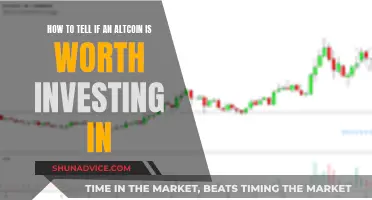
Bitcoin derivatives are financial instruments that allow people to invest in Bitcoin without actually owning the cryptocurrency. Derivatives are complex financial contracts that take place between a buyer and a seller, and they often involve high-risk, high-return strategies. Crypto derivatives enable traders to speculate on the price movement of Bitcoin and other cryptocurrencies, and they can be used to hedge against market volatility and diversify crypto portfolios. There are three main types of derivatives contracts in the crypto markets: futures, options, and perpetual swaps.
| Characteristics | Values |
|---|---|
| Definition | Tradeable financial contracts that derive their value from underlying crypto assets |
| Trader's Action | Place their bet based on speculation of the price movements of crypto tokens, and can choose to either sell or buy the asset |
| Transaction | Can happen through physical delivery of crypto tokens, or directly through cash settlement into the trader’s account without owning the asset |
| Risk | High-risk financial instrument |
| Trader Type | Advanced traders |
| Volatility | Crypto market is extremely volatile |
| Investment Portfolio | Derivatives can make investment portfolios much riskier |
| Types | Crypto futures contracts, perpetual contracts, and options |
| Crypto Futures Contracts | Two parties agreeing on the predetermined price for buying and selling crypto tokens, such as Bitcoin or Litecoin, and comes with an expiration date for the contract to end |
| Crypto Perpetual Contracts | Similar to futures contracts, but without an expiration date |
| Options | Give traders the option to fulfill the contract, but doesn’t bind them to buy or sell the underlying crypto at a predetermined price on or before the expiration date |
| Pros | Can be used to hedge against market volatility and diversify crypto portfolio |
| Cons | Poor trading strategies, and taking unnecessary leverage may pose high risk |
What You'll Learn

Understanding crypto derivatives
Crypto derivatives are financial instruments that derive their value from underlying crypto assets. They are contracts between two parties that allow traders to speculate on the price movements of cryptocurrencies without actually owning the underlying asset. Crypto derivatives are not exclusive to crypto; these types of assets are also popular in traditional finance. Crypto derivatives are primarily used for speculation, hedging, and leverage.
The speculation involves taking a position on the future price movements of crypto to make a profit. This allows traders to take advantage of the high volatility of the crypto market, as it can help them earn significant profits if they correctly predict the future price movements of the underlying asset. This way, traders can capitalize on market opportunities by going long or short.
While spot trading also allows speculation—buying low and selling high—leverage is what makes derivatives attractive to traders. Leverage trading is the ability to control a large amount of an asset with a relatively small amount. For example, a trader may only need to put down 10% of the total value of a futures contract. Derivatives allow traders to enter larger positions than their capital would allow in the spot market.
Hedging is another reason for using crypto derivatives. It is a risk management strategy where a trader takes an opposite position to an existing one to offset potential losses. For example, a Bitcoin spot holder buys an asset and then holds it until the value increases. However, if they think the asset might decrease in value, they can take a short position on a Bitcoin futures contract, effectively hedging their position. Crypto derivatives can be used to hedge digital asset market exposure, thus reducing market risk.
There are three main types of derivatives contracts in the crypto markets: futures, options, and perpetual swaps.
Futures are financial derivatives contracts where there is an obligation to buy or sell the underlying asset at a predetermined date and price in the future. Cryptocurrency futures enable you to go long or short on a crypto asset using leverage, allowing you to speculate on future price developments or hedge market exposure.
Options are derivative contract agreements where you receive the right, but not the obligation, to buy or sell an underlying asset at a set price at a predetermined date in the future. The option buyer enjoys the right, but the option seller has an obligation to fulfill their part of the contract if the option holder so chooses. Similarly to futures, you can use cryptocurrency options to speculate on price movements or hedge digital asset market exposure.
Perpetual swap contracts are financial derivatives that allow you to speculate on the price movement of crypto assets using leverage. But unlike traditional futures contracts, perpetual swaps don’t have expiration dates.
Edward Jones: Bitcoin Investment Options and Opportunities
You may want to see also

How to trade Bitcoin futures
Trading in Bitcoin futures can be a complex process and is not recommended for beginners. It involves a lot of speculation, and given the volatile nature of Bitcoin, it can be a risky endeavour.
A futures contract is an agreement to buy or sell an asset at a future date for a predetermined price. Bitcoin futures contracts allow investors to speculate on and take advantage of the currency's future price without actually holding any Bitcoin. The buyer can lock in a lower price, and the seller can lock in a higher price for a future transaction.
The Chicago Mercantile Exchange (CME) is a popular platform for trading Bitcoin futures. It offers monthly contracts for cash settlement, meaning investors receive cash instead of Bitcoin upon settlement. CME's BTC contract is USD-cash settled, based on the CME's Bitcoin Reference Rate (BRR). This rate is a daily reference for the USD price of one Bitcoin.
To trade Bitcoin futures, you will need to open an account with a registered broker who will maintain your account and guarantee trades. These brokerage firms are known as either a futures commission merchant (FCM) or introducing broker (IB).
When trading Bitcoin futures, it is important to understand the concept of leverage. Each Bitcoin futures contract represents five Bitcoins, so there is inherent leverage in the market. Traders often use this leverage to speculate on short-term market swings, attempting to generate large returns on small upfront investments.
It is also important to be aware of the risks involved. As well as the volatile nature of Bitcoin, investors are subject to margin calls, which can force the liquidation of positions if minimum margin requirements are not met. There are also exchange fees to consider, which can eat into trading profits.
Overall, trading Bitcoin futures can be a useful way to gain exposure to Bitcoin without directly buying and holding the tokens. However, it is a complex strategy that requires a good understanding of the market and is not recommended for beginners.
Investors Betting on Bitcoin: How Many?
You may want to see also

How to trade Bitcoin options
Bitcoin options are a type of financial derivative contract that enables investors to speculate on the price of Bitcoin, the digital currency. They are available on traditional derivatives exchanges and crypto trading platforms.
Step 1: Understanding Bitcoin Options
Firstly, it is important to understand what Bitcoin options are and how they work. Bitcoin options are financial derivatives contracts that give you the right to buy or sell Bitcoin at a predetermined price, known as the strike price, on a specific future date. There are two main types of Bitcoin options:
- American options allow investors to exercise their rights and close a position at any time before the specified expiration date.
- European options limit investors to closing a position and ending their contract on the specified expiration date.
Step 2: Choosing an Options Trading Platform
When choosing a platform, look for one with ample liquidity and a high level of security. Examples of crypto trading platforms that provide Bitcoin options include Bybit, Deribit, OKX, and Bit.com.
Step 3: Opening an Options Trading Account
To open an account, you will typically need to provide personal information such as your name, email address, and password. Some platforms may also require you to provide a scanned copy of your government-issued ID and proof of address.
Step 4: Funding Your Account
After opening your account, you will need to deposit funds. You can usually use either fiat currency or cryptocurrency to fund your account.
Step 5: Developing a Trading Strategy
Before placing any trades, it is crucial to develop a comprehensive trading strategy. This should be based on an understanding of market dynamics and Bitcoin price movements.
Step 6: Placing Your First Trade
Once you have a clear strategy in place, you can place your first trade. Keep in mind that trading Bitcoin options is riskier and more complex than trading spot Bitcoin, so make sure you understand the risks involved.
Step 7: Monitoring and Managing Your Trades
After placing your trades, it is important to monitor the market and your positions regularly. This will help you identify when to make adjustments or close out your positions.
Key Considerations:
- Risk and Complexity: Trading Bitcoin options is generally riskier and more complex than buying and selling Bitcoin in the spot market.
- Fees: Trading fees, margin requirements, and other transaction costs can impact your potential profits or losses.
- Regulatory and Platform Risks: The regulatory landscape for crypto options can be uncertain, and some platforms may have security issues.
- Volatility: Cryptocurrencies are volatile, and this can lead to rapid changes in the value of options.
- Time Decay: Options have an expiration date, and their value can decrease over time as they get closer to the expiration date.
- Taxes: Profits from crypto options are typically subject to capital gains tax.
The Ultimate Guide to Investing in Bitcoin
You may want to see also

The pros and cons of crypto derivatives
Crypto derivatives have become a highly popular part of the global crypto markets, allowing traders to execute a range of different trading strategies. Derivatives are financial instruments that derive their value from underlying crypto assets. They are complex financial contracts that take place between a buyer and a seller, and often involve high-risk, high-return strategies.
Pros
- Leverage: Derivatives allow traders to enter larger positions than their capital would allow in the spot market.
- Risk Mitigation: Crypto derivatives can be used to hedge digital asset market exposure, thus reducing market risk.
- Ability to Execute Complex Trading Strategies: Cryptocurrency derivatives allow traders to deploy advancing trading strategies, such as betting on the volatility of the price of a crypto asset.
- Flexibility: Even non-crypto holders can predict an asset’s price movements and earn profits.
- Hedging: Can be used to hedge against market volatility and diversify crypto portfolios.
- Low Transaction Costs: Derivative contracts are effective risk management tools, reducing market transaction costs.
- Liquidity: Derivatives facilitate market liquidity, impacting the ease with which traders can open or close positions.
- Price Discovery: Crypto derivatives enable the optimisation of price discovery by allowing investors to either go long or go short, making mechanisms for price discovery more efficient.
Cons
- Leverage: While crypto derivatives traders can potentially benefit from using leverage to amplify their potential trading profits, it can also amplify losses. Given the volatile nature of cryptocurrencies, losses can be significant if not adequately hedged.
- Regulatory: Cryptocurrencies’ legal framework is inconsistent across jurisdictions and can present certain compliance and regulatory risks.
- Counterparty Risks: In the over-the-counter (OTC) derivative market, traders face default credit risk. The due diligence and transaction security exchanges offer are not available for OTC derivatives trade.
- Risk: Poor trading strategies, and taking unnecessary leverage may pose high risk.
- Risk: Crypto’s volatile nature can either lead to profit or loss due to price fluctuation.
Gold Coin Investment: Where to Buy?
You may want to see also

How to start investing in crypto derivatives
Crypto derivatives are financial instruments that allow you to speculate on the price movement of cryptocurrencies like Bitcoin without actually owning them. They are complex and best suited for advanced traders. Crypto derivatives are of three main types: futures, options, and perpetual swaps/perpetual contracts.
Step 1: Understand the Basics
Firstly, it is important to understand how crypto derivatives work. Derivatives are financial contracts between a buyer and a seller that derive their value from an underlying asset, in this case, a cryptocurrency like Bitcoin. These contracts specify conditions for the purchase or sale of the underlying asset, including the contract's validity period, price, and quantity.
Step 2: Choose a Type of Derivative
As mentioned earlier, the three main types of crypto derivatives are futures, options, and perpetual contracts.
- Futures: These are agreements between a buyer and a seller to buy or sell an underlying asset (e.g., Bitcoin) at a predetermined price and date in the future.
- Options: These contracts give the holder the right but not the obligation to buy or sell an underlying asset at a set price by a certain date.
- Perpetual Contracts: These are similar to futures but do not have an expiration date, allowing traders to hold their positions (long or short) indefinitely.
Step 3: Select a Crypto Exchange
Choose a reliable and established crypto exchange that offers derivatives trading, such as Binance, Huobi Global, ByBit, OKEx, or Bitmex. These platforms will provide you with the necessary tools and markets to trade derivatives.
Step 4: Register and Set Up Your Account
Follow the registration process on your chosen crypto exchange, which usually involves providing your email address and setting up a password. You may also need to verify your email and provide additional personal information for Know Your Customer (KYC) requirements, depending on your location.
Step 5: Fund Your Account
Once your account is verified, you can add funds to it. This can typically be done by linking your bank account, authorizing a wire transfer, or using a credit or debit card. Ensure you only invest an amount you are comfortable losing, as derivatives trading can be risky.
Step 6: Create a Crypto Wallet
Set up a crypto wallet, which is a software program that allows you to send, receive, and store cryptocurrencies. This will be necessary for holding your derivatives and facilitating transactions.
Step 7: Place Your First Trade
Now you're ready to place your first crypto derivatives order! Select the crypto pair you want to trade, such as BTC/USDT or DOGE/USDT, and decide whether you want to take a long (buy) or short (sell) position. Remember to do your research and understand the risks involved before placing any trades.
Step 8: Monitor and Manage Your Trades
Keep a close eye on your trades and the market conditions. You may want to set up price alerts to help you track your positions. Additionally, consider implementing risk management strategies, such as stop-loss orders, to limit potential losses.
Step 9: Stay Informed and Educated
Continuously educate yourself about the crypto markets, derivatives trading strategies, and risk management techniques. Stay up to date with the latest news and analysis to make informed trading decisions.
Step 10: Practice Risk Management
Derivatives trading can be highly risky, so it's crucial to manage your risk effectively. Understand concepts like leverage and margin, and only use amounts of capital that you are comfortable losing. Diversifying your portfolio and implementing hedging strategies can also help mitigate risk.
Remember that crypto derivatives are complex financial instruments, and it's important to thoroughly understand them before investing. Always do your own research and consult with a financial advisor if needed to ensure you make informed investment decisions.
Trump's Bitcoin Investment: A Political Gamble?
You may want to see also
Frequently asked questions
Bitcoin derivatives are financial instruments that derive their value from Bitcoin. They allow traders to speculate on the price movement of Bitcoin without actually owning it.
You can invest in Bitcoin derivatives by opening an account with a crypto exchange, verifying your identity, adding funds to your account, setting up a crypto wallet, and then placing your order.
Bitcoin derivatives are complex financial instruments that are considered high-risk due to the volatility of the crypto market. They can result in significant gains or losses, depending on price movements.







